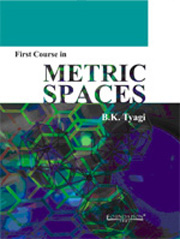Book contents
- Frontmatter
- Preface
- Contents
- 1 Preliminaries
- 2 Basic Concepts in Metric Spaces
- 3 Sequences in Metric Spaces
- 4 Limits and Continuity
- 5 Completeness
- 6 Compactness
- 7 Connectedness
- 8 Approximations
- 9 Fixed Point Theorems and Their Applications
- 10 A Construction of Real Number System
- Appendix A Definition of Sets as Cumulative Type Structures
- Appendix B Bibliography
- Index
9 - Fixed Point Theorems and Their Applications
Published online by Cambridge University Press: 05 April 2012
- Frontmatter
- Preface
- Contents
- 1 Preliminaries
- 2 Basic Concepts in Metric Spaces
- 3 Sequences in Metric Spaces
- 4 Limits and Continuity
- 5 Completeness
- 6 Compactness
- 7 Connectedness
- 8 Approximations
- 9 Fixed Point Theorems and Their Applications
- 10 A Construction of Real Number System
- Appendix A Definition of Sets as Cumulative Type Structures
- Appendix B Bibliography
- Index
Summary
Let X be a set, and f : X → X be a mapping. A point x in X is said to be a fixed point of f if f(x) = x. There are a number of problems in mathematics whose solutions are fixed points of certain mappings. Sometimes it is not possible to find a fixed point of a mapping exactly. Approximation methods are applied to get a value which is near to the required fixed point. Newton's method in numerical analysis can be considered such an approximation method. Some of these problems will be discussed in this chapter.
Fixed Point Theorems
Let X be a set, and f : X → X be a mapping. Then f need not have a fixed point. However, if we impose a certain mathematical structure on X and f, then f may have a fixed point. Our first attempt in this direction is the following.
Theorem 9.1.1 Every continuous function f : [a, b] → [a, b] has atleast one fixed point.
Proof. If a or b is a fixed point of f, then there is nothing to prove. So we assume that f(a) ≠ a and f(b) ≠ b.
Let us define a function g : [a, b] → [a, b] by setting g(x) = f(x) - x. Then g is obviously a continuous function. Since f(a) is in [a, b], f(a) > a. Similarly, f(b) < b. This means that g(a) > 0, and g(b) < 0.
- Type
- Chapter
- Information
- First Course in Metric Spaces , pp. 319 - 332Publisher: Foundation BooksPrint publication year: 2010



